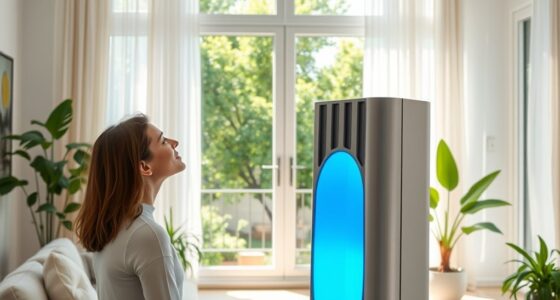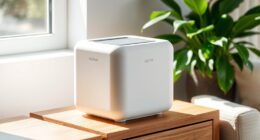Maintaining indoor humidity between 40% and 60% helps support your respiratory health, skin, and immune system. It prevents dry mucous membranes that can trap infections and reduces mold growth that worsens allergies and asthma. Proper humidity also keeps your skin moisturized and your air fresh, boosting comfort and energy efficiency. Staying within this range minimizes irritants and promotes better overall health. If you want to learn more about controlling humidity effectively, keep exploring the key strategies that work best.
Key Takeaways
- Maintains mucous membrane moisture, reducing respiratory irritation and lowering infection risk.
- Prevents mold growth and dust mites, supporting allergy and asthma management.
- Preserves skin hydration, preventing dryness, cracking, and skin barrier impairment.
- Enhances indoor comfort and energy efficiency by making spaces feel warmer at lower temperatures.
- Supports immune function by keeping respiratory and mucous membranes resilient against pathogens.
How Humidity Levels Affect Respiratory Health
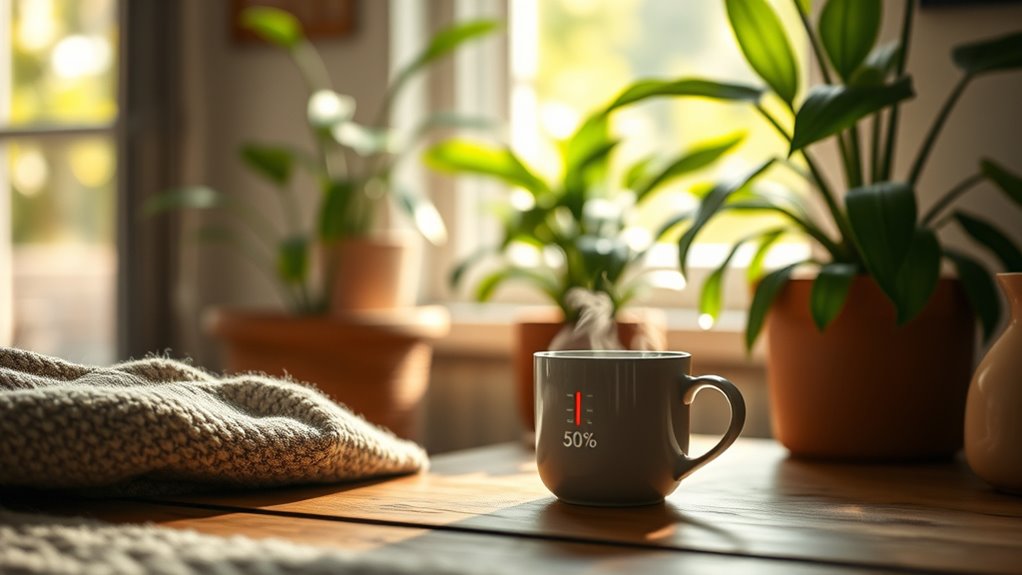
When indoor humidity levels fall below the recommended range, your respiratory system can become more vulnerable to irritation and infections. Low humidity dries out your mucous membranes, making it harder for your body to trap and eliminate airborne pathogens. This can lead to increased coughing, sore throats, and respiratory discomfort. Maintaining proper humidity supports overall comfort and helps prevent respiratory issues. Additionally, humidity and comfort are closely linked; a balanced level keeps your environment pleasant and reduces the likelihood of dry air-related symptoms. Proper humidity also enhances energy efficiency because a well-humidified space feels warmer at lower temperatures, reducing your need for excessive heating. Maintaining optimal color accuracy in your indoor environment can also contribute to improved visual comfort and reduce eye strain. Keeping humidity within 40-60% ensures your respiratory health and promotes a cozy, energy-efficient indoor environment.
The Role of Humidity in Skin and Mucous Membrane Integrity

Maintaining ideal humidity levels is essential for preserving the integrity of your skin and mucous membranes. Proper humidity supports skin hydration, preventing dryness, cracking, and irritation. When humidity falls below 40%, your skin can lose moisture, weakening its protective barrier. Similarly, the mucous barrier in your nose, mouth, and throat relies on adequate humidity to stay intact and functional. Without enough moisture, these barriers become compromised, making you more vulnerable to irritants and pathogens. By keeping the humidity within the 40–60% range, you help maintain the natural moisture balance, ensuring your skin remains supple and resilient. This balance also supports the mucous membranes’ ability to trap and clear harmful particles, contributing to your overall health and comfort. Incorporating vegetable juices into your diet can further support skin and mucous membrane health by providing essential nutrients and antioxidants.
Impact of Low Humidity on Immune Function

Did you know that low humidity can weaken your immune system’s ability to fight off infections? When the air is too dry, your mucous membranes become less effective at trapping pathogens, leading to immune suppression. This reduces your body’s first line of defense, making it easier for bacteria and viruses to invade. Additionally, low humidity creates an environment conducive to pathogen proliferation, especially on surfaces and in the air. As a result, you become more vulnerable to illnesses like colds and flu. Maintaining proper humidity levels helps support your immune function by keeping mucous membranes moist and resilient. When humidity drops below 40%, your immune system faces increased challenges, making it essential to keep indoor humidity within the recommended range for ideal health. Automation in business advancements can also aid in monitoring and regulating indoor environments to maintain optimal humidity levels.
Risks of Excessive Humidity and Mold Growth
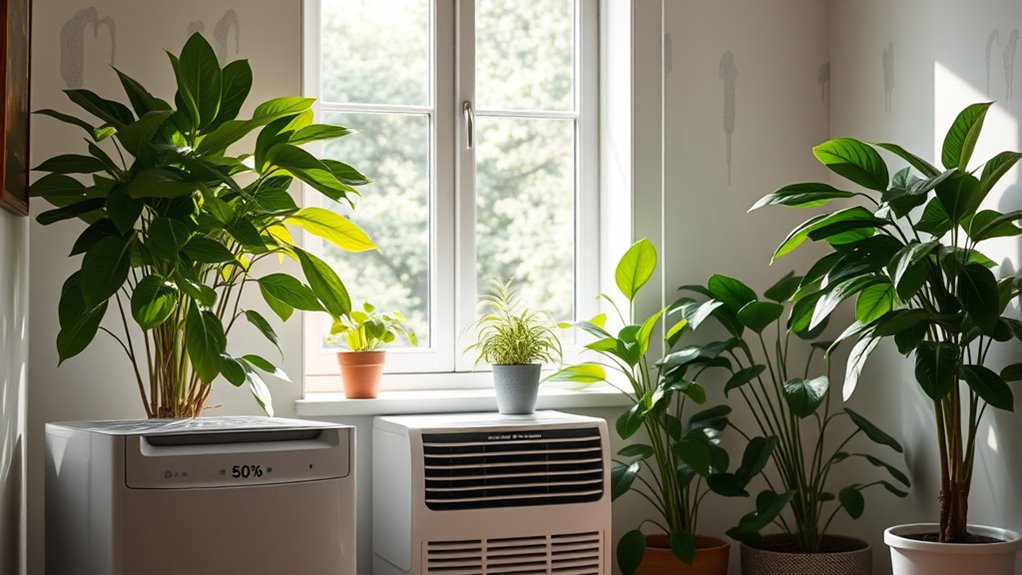
When humidity levels rise above 60%, mold can start to grow quickly in your home. This can worsen allergies, cause respiratory issues, and lead to unpleasant odors. Additionally, excessive moisture can damage your property’s structure over time. Regularly monitoring humidity levels is essential to prevent these issues and maintain a healthy indoor environment.
Mold Allergies Increase
Excessive humidity creates an ideal environment for mold to thrive, which can considerably worsen allergies and respiratory issues. Mold allergies become more severe when humidity levels are too high, as mold spores flourish in damp, poorly ventilated spaces. If you neglect humidity control, you increase your risk of exposure to mold spores, leading to sneezing, nasal congestion, coughing, and itchy eyes. These allergic reactions can persist or worsen over time, especially in areas with persistent moisture. To reduce mold allergies, it’s vital to maintain proper humidity levels—ideally between 40-60%. Proper humidity control not only limits mold growth but also creates a healthier environment for you and your family, decreasing allergy symptoms and improving overall air quality. Using an air purifier with HEPA filtration can help remove airborne mold spores and allergens, further supporting a healthier indoor environment.
Respiratory Complications Rise
High humidity levels can especially increase your risk of respiratory problems by fostering mold growth and airborne irritants. Fluctuations in humidity create an environment where mold thrives, worsening breathing issues. Excess moisture can also compromise indoor plant health, leading to decaying leaves that release mold spores. To better understand this, see the table below:
| Humidity Level | Effect on Respiratory Health |
|---|---|
| Above 60% | Promotes mold, airborne irritants |
| 40–60% | ideal for health, mold control |
| Fluctuations | Increases mold risk, irritants |
| Indoor Plant Health | Decay and mold spread |
Maintaining proper humidity stabilizes indoor air, reduces mold risks, and keeps your respiratory system healthier. For precise control, using a hygrometer can help monitor and maintain optimal humidity levels.
Structural Damage Accelerates
Elevated humidity levels can cause immediate structural issues by weakening building materials and promoting mold growth. Excess moisture penetrates building insulation, reducing its effectiveness and accelerating deterioration. Over time, this moisture compromises the structural integrity of walls, ceilings, and foundations, making them more prone to cracks and collapse. Mold growth further accelerates damage, as fungi break down organic materials like wood and drywall. This deterioration not only weakens the building but also increases repair costs and safety risks. Maintaining proper humidity levels helps preserve the strength of your structure and prevents moisture from infiltrating critical components. By controlling humidity, you protect your home’s stability and avoid the costly consequences of accelerated structural damage caused by excessive moisture.
Signs That Your Indoor Humidity Is Outside the Recommended Range
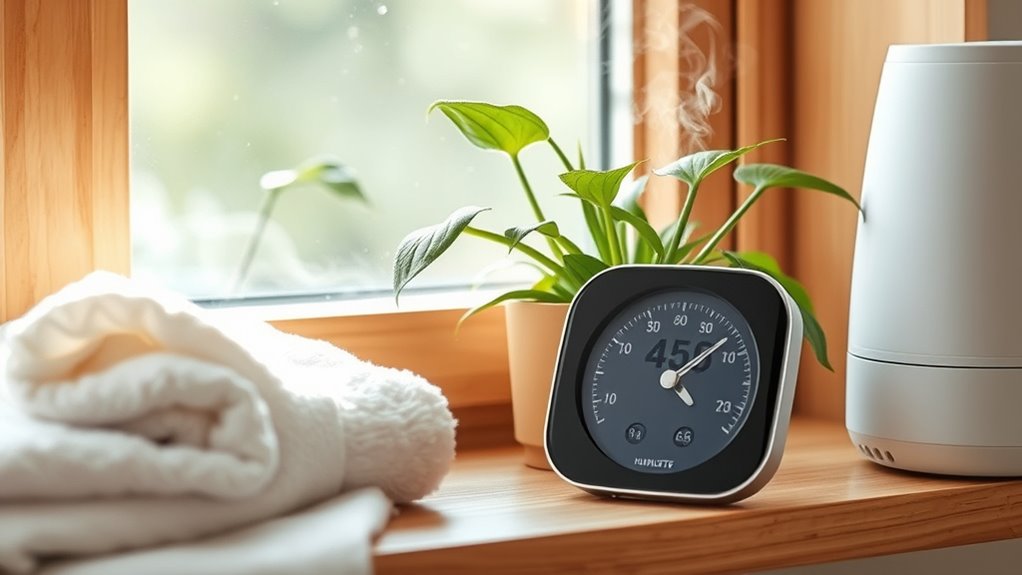
You might notice visible mold or musty odors when your indoor humidity is too high. Uncomfortable breathing, such as congestion or throat irritation, can also signal humidity levels are off. Paying attention to these signs helps you keep your environment healthy and comfortable. Additionally, using a humidifier or dehumidifier can help maintain optimal humidity levels and prevent these issues.
Visible Mold Growth
Visible mold growth is a clear sign that your indoor humidity levels may be outside the ideal 40–60% range. When you see mold, it indicates moisture is condensing on surfaces, creating a perfect environment for mold prevention issues. Regular humidity monitoring helps catch these problems early, reducing mold risk. Keep an eye out for:
- Discolored spots on walls or ceilings
- Black, green, or white patches on surfaces
- A musty smell lingering in rooms
- Water stains or peeling paint
- Excessive condensation on windows or walls
If you notice these signs, address humidity imbalances promptly. Controlling moisture levels can prevent mold growth and protect your health. Maintaining proper humidity not only safeguards your home but also promotes a healthier living environment. Proper humidity levels play a crucial role in reducing mold growth and maintaining indoor air quality.
Uncomfortable Breathing
Have you noticed that breathing feels more difficult or stuffy than usual? This can be a sign that your indoor air quality is suffering because humidity levels are outside the ideal 40–60%. When the air is too dry, nasal passages and lungs dry out, causing discomfort and making it harder to breathe. Conversely, excessive humidity can lead to stuffiness and a feeling of heaviness, as moisture builds up in the air. These fluctuations disrupt your comfort levels and can cause respiratory irritation. If you’re experiencing persistent difficulty breathing or a feeling of congestion indoors, check your humidity levels. Maintaining the proper range helps stabilize your air quality, making breathing easier and ensuring a healthier, more comfortable environment. Incorporating sound design techniques like ambient sounds or white noise can also promote relaxation and respiratory comfort in your space.
Practical Strategies to Maintain Optimal Indoor Humidity
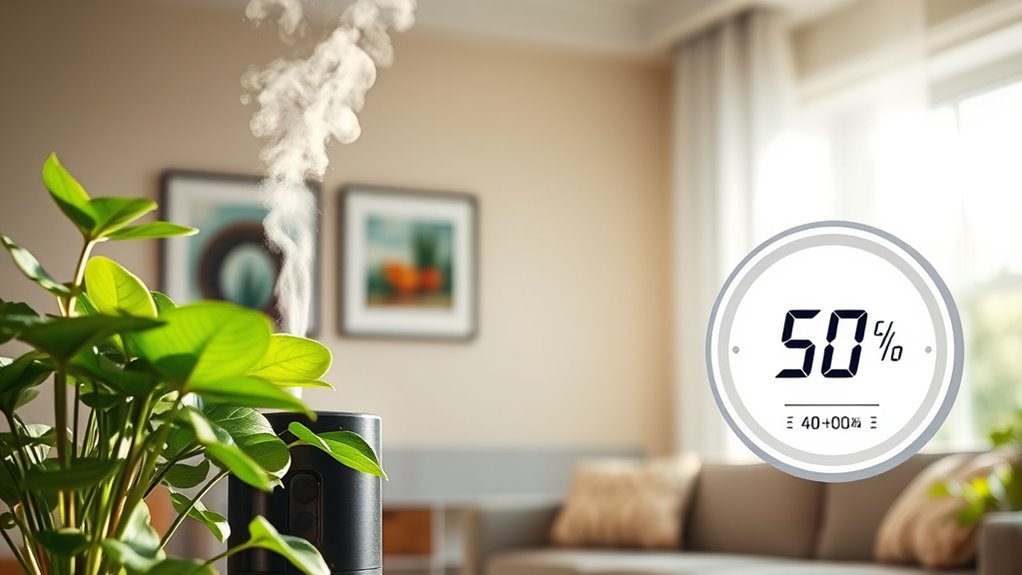
Maintaining ideal indoor humidity levels between 40% and 60% can be achieved through practical strategies that are easy to implement. Start by using humidity sensors to monitor your home’s moisture levels accurately. Keep your dehumidifier well-maintained to guarantee it functions effectively, preventing excess humidity. Ventilate regularly by opening windows when outdoor humidity is low. Use exhaust fans in kitchens and bathrooms to reduce moisture buildup. Additionally, place houseplants that naturally regulate humidity, and avoid overwatering them. Consider using a humidifier during dry seasons to add moisture when needed. Regularly check dehumidifier maintenance and calibration of humidity sensors to maintain consistent comfort and health benefits. Being mindful of the importance of humidity levels helps ensure a healthy indoor environment. These simple steps help you keep indoor humidity in the ideal range effortlessly.
Equipment and Technologies for Humidity Control

Modern humidity control relies on a variety of advanced equipment and technologies designed to create and maintain ideal indoor moisture levels. Industrial humidifiers are effective for adding moisture in large spaces, ensuring consistent humidity. Dehumidification systems remove excess moisture, preventing mold and discomfort. These tools often include smart sensors and automated controls for precise regulation. Proper maintenance of humidification equipment is essential to ensure continuous and efficient performance.
| Equipment Type | Function | Ideal Use Case |
|---|---|---|
| Industrial Humidifiers | Increase humidity levels | Large commercial or industrial spaces |
| Dehumidification Systems | Reduce humidity levels | Damp environments or allergy-prone areas |
| Humidity Sensors | Monitor moisture levels | Continuous feedback for control |
| Automated Controllers | Adjust equipment operation automatically | Maintain stable humidity levels |
Together, these technologies ensure your indoor environment stays within the excellent 40–60% range.
The Connection Between Humidity and Allergies or Asthma

Since humidity levels directly influence indoor air quality, they play an essential role in managing allergies and asthma symptoms. Fluctuations in humidity can cause allergen proliferation, worsening symptoms or triggering attacks. Maintaining a steady 40–60% humidity helps prevent mold growth, dust mites, and other allergens from thriving. When humidity drops too low, airborne irritants like pollen and pet dander become more persistent, irritating your airways. Conversely, high humidity promotes mold and mildew, which can worsen asthma. Monitoring and controlling humidity minimizes these risks, creating a healthier environment. Proper air quality management is crucial for reducing indoor allergens and supporting respiratory health.
Long-Term Benefits of Proper Humidity Management

Proper humidity management offers lasting health benefits by reducing the risk of respiratory issues and chronic conditions. When you use humidity sensors, you can monitor moisture levels accurately, ensuring they stay within the ideal 40–60%. Proper dehumidifier placement is key to maintaining consistent humidity, preventing mold growth and dust mites. Over time, this helps improve lung function and lowers allergy symptoms. Additionally, understanding Bitcoin IRA strategies can inform how you protect your health investments through secure and diversified assets.
Frequently Asked Questions
How Does Humidity Affect Indoor Plant Health?
Humidity directly impacts your indoor plants’ health. When humidity is balanced, plants absorb water more efficiently during plant watering, reducing stress and promoting growth. Proper humidity levels also help prevent pests, which thrive in dry or overly humid environments. You should monitor humidity carefully, ensuring it stays within 40–60%, so your plants stay healthy, hydrated, and pest-free. This balance creates ideal conditions for their overall well-being.
Can Maintaining Proper Humidity Reduce Static Electricity?
Did you know that static shocks can happen more often in dry environments? Proper humidity regulation, ideally between 40-60%, can substantially reduce electrostatic buildup. When humidity is too low, static electricity increases because dry air doesn’t dissipate charge well. By maintaining ideal humidity levels, you create a more conductive atmosphere, preventing static shocks and protecting electronic devices, your skin, and even your clothing from unnecessary static cling.
What Are the Economic Benefits of Controlling Indoor Humidity?
Controlling indoor humidity offers notable economic benefits. By maintaining ideal humidity levels, you can achieve cost savings through reduced energy consumption, since your heating and cooling systems don’t need to work as hard. Additionally, proper humidity control prevents damage to furniture and electronics, saving you repair and replacement costs. Overall, investing in humidity management boosts energy efficiency and lowers your long-term expenses, making your home more financially sustainable.
How Does Humidity Influence Indoor Air Quality Sensors?
Oh, the irony—you rely on indoor air quality sensors, yet humidity can throw them off. When humidity levels fluctuate, sensors struggle with accurate calibration and moisture detection, leading to false readings. You might think your environment’s fine, but in reality, high or low humidity distorts data, making it harder to maintain healthy air. So, controlling humidity ensures your sensors work correctly, giving you real insights into your indoor air quality.
Are There Seasonal Variations in Ideal Indoor Humidity Levels?
You might notice seasonal fluctuations in indoor humidity levels, as temperature changes affect moisture retention. During winter, you’ll likely need to increase humidity through humidifiers, while in summer, dehumidifiers can help lower it. Proper humidity regulation guarantees comfort and health, preventing issues like dry skin or mold growth. Adjusting your humidity controls seasonally helps maintain a consistent, healthy environment, regardless of outside weather variations.
Conclusion
Keeping your indoor humidity between 40-60% is like tending a delicate garden—too dry or too damp, and everything suffers. When you maintain this balance, your respiratory health, skin, and immune system flourish like vibrant flowers. Avoid mold and allergens as if they’re pesky weeds. With simple adjustments and the right tools, you can create a comfortable, healthy environment that nurtures your well-being, turning your home into a sanctuary where health blooms beautifully.





